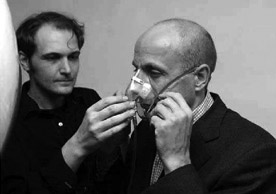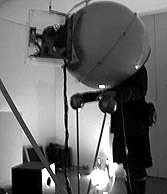

Tobias Grewenig has conceived the installation Emotion’s Defibrilator as a play on the clichés of consciousness-manipulation through electronics. His piece doesn’t deliver any content as such, but instead tries to reduce the media on their pure physiological effect on the recipient. In Grewenig’s view, the bodily effects of media have rarely been considered and often they range from conspiracy theories about subliminal messages to almost folkloristic ideas about the effects of electro-magnetic pollution.
The user of the installation, wearing an oxygen mask and a pincer on his left forefinger that will measure his/her pulse, puts his head into a big sphere. By placing the hands on two metalic spheres, the equipment is set in motion. First, bio data such as respiration, pulse and skin resistance are measured by the sensors and sent to the software to define the starting parameters. There are various sources of audio and a screen within the sphere. In relation to the data picked up from the body, the audio resonates, tiny electric shocks are delivered via the metallic spheres while the screen shows a flickering image of the user which is being interrupted by “subliminals”. When the user takes the hands off the spheres, the installation stops.
Grewenig says that it’s fascinating to observe how the electronic equipment, although basically off-the-shelf material, starts frightening its user and turns into something profoundly unpredictable. This already happens when the sensoric input is roughly at the level of everyday city-life. (Well, plus electric shocks, that is.)
Related: Dunne and Raby’s Placebo Objects and Hertzian Tales, Death Before Disko by Herwig Weiser.
Via neural.
